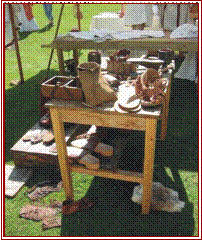Shoe Making
Throughout the Empire a great variety of different shoes and sandals can be found. From the airy caligae to the more enclosed boots found in Britannia and other Northern European regions. A good number of patterns and styles are known to us, predominately from statues and other mediums less prone to deterioration than the actual leather used in the footwear itself. Although such finds are rare, a fair number of Roman sandals have been discovered in either bogs or sand, both helping to preserve the leather to an identifiable degree. For an example see here on a page of the University College London's web site.
Some of the footwear worn at our shows is home-made. Roman shoes are typically very simple to make, though making them is time-consuming. There are no known manuals left by the Romans on shoe manufacture. However, it is fairly easy to guess the shoes' construction from what has survived. Normally, footwear is built up of a number of layers of leather for the sole, the actual shoe, plus a couple more layers of leather for the insole. There is some evidence that shoes were lined in colder climates, and that simple socks were worn. Shoes appear to have been either stitched, glued, pegged or nailed together, and in some cases, a combination of all four methods was used.
When people see Roman shoes being made, they are often surprised at how similar they are to our own modern shoes. Many people have commented that the designs are intrinsically the same – all that has changed is the tools.
Soon, we hope to show pictures of basic shoe construction from caligae to carbatinae, along with their stages of production. In the meantime I recommend a visit to Matthew Amt's section on caliga construction, which includes helpful hints and a pattern or two to use.






